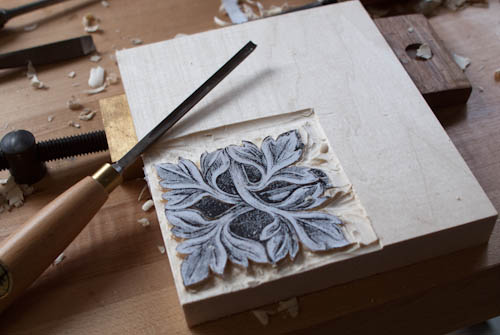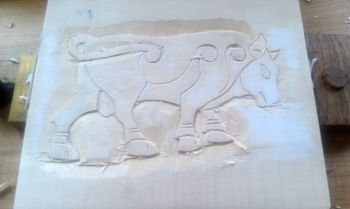 I normally don't like showing pictures of works in progress. But my camera was set up for another project and while I am not done with this carving, I think it is coming along pretty well. After a lapse of several months not carving, I'm back at it and making progress. For those of you starting out the idea of getting from here to there might seem daunting, and it is, and for me this pattern is the first thing I have tried to do flying solo without the benefit of Chris Pye's instruction. Mind you it's not that I don't need the instruction, or that I don't expect to continue the instruction, but after carving the bull in Chris Pye's Woodcarving Course & Reference Manual three times, and getting really inspired by the design in issue 10 of work, I really wanted to give this pattern a whack. And this really is the whole point of studying anything - so when the spirit moves you you feel competent enough to take a whack. I normally don't like showing pictures of works in progress. But my camera was set up for another project and while I am not done with this carving, I think it is coming along pretty well. After a lapse of several months not carving, I'm back at it and making progress. For those of you starting out the idea of getting from here to there might seem daunting, and it is, and for me this pattern is the first thing I have tried to do flying solo without the benefit of Chris Pye's instruction. Mind you it's not that I don't need the instruction, or that I don't expect to continue the instruction, but after carving the bull in Chris Pye's Woodcarving Course & Reference Manual three times, and getting really inspired by the design in issue 10 of work, I really wanted to give this pattern a whack. And this really is the whole point of studying anything - so when the spirit moves you you feel competent enough to take a whack.
I should mention I started carving this morning and I am probably only a half hour into actual carving. I did have to stop and sharpen a bunch of tools first. That probably took another half hour.
Let's review.
What have I learned so far?
1 - Carving for me, a less than talented iron monger, is possible. I doubt I will be the next Gibbons but I'm getting real satisfaction over all of this and I might have something to show for it.
2 - Learning to sharpen carving tools. Before studying with Chris I knew how to sharpen carving tools, but I am a firm believer in that if you study with someone you follow their methodologies until you either adopt them automatically, or you stop studying with them. Their classroom, their rules. As a result my carving tool sharpening which was okay before is far better now. I learned a lot about tool geometry, but also following a rigorous method made me more consistent in getting great results. I have a far better idea how well a tool should cut, and I also learned a bunch of tips and tweaks. Early on I watched all of Chris' videos on sharpening and getting that part of carving down. Sharp tools have made all the difference. I am carving now, not fighting dullness.
I sent Chris an advanced copy of this blog and his comment was: "Did you mean that? Wasn't it more, 'I only had a vague idea how to ...'?!"
My response is that from a master's' standpoint I might had had only a vague idea, but from my standpoint I was fine and could get stuff done, just maybe not well enough to get to the next level. Getting to the next level is why I am studying in the first place and I am making progress.
3 - The basic hand holds. It's kind of dumb but as someone used to using tools I am also used to feeling confident on being able to use new and different tools. The idea that certain hand holds work better than others seems obvious in retrospect but it wasn't then. The videos helped but the real way I learned the handholds was following the exercises in the book long enough so when I actually showed Chris what I was practicing he didn't visibly cringe. And according to instruction, I practiced with both hands, now I feel I can really control the tools, and use them easily with both hands. This is interesting. Sometimes when I read a how-to book I selectively pick and choose what I want to learn and what I am willing to practice. Here, because I was studying with a human (something I haven't done in twenty years), I wasn't able to gloss over stuff and the discipline of being in an actual course paid off. Using both hands has made for far faster carving and fewer bad cuts made because the work and tool weren't oriented corrected. I kind of doubled the amount of carving I can do without shifting anything.
4 - For some people the actual goal of study is to simply finish the course. That's not what I hope to do. I don't have any real interest in figurative carving, what I want to be able to do is carve decorative borders and things with a fluency that one needs in order to do repetitive work without it becoming tedious. The best part of this current project is that I finally have a sense of how the tools should behave and I am not scared of keeping them in control. When I carved the bull I had a lot of trouble getting the result I saw in my mind's eye, but it got better as I worked. I feel pretty hesitant about if I can carve the leaves to look like leaves, but I'm pretty confident about the process of carving the basic design. In other words the lessons I have taken have took, I have actually learned something, practice is crystallizing in my hands, and I can move forward.
5 - Early in Chris' books he talks about having a proper place to carve, treating your tools properly, and in general being ready to carve. Some people do great work just sitting on the porch with a penknife. Not me. Because I decided to do this study formally, I had to make a commitment in tools, setup time, and a place to work. I put a small worktable in my office and 'm glad I did, I'm easily frustrated if I have to constantly set things up but now I am having a grand time of it. I felt the layout for a new bench was an important message of commitment to myself that I would not have made if I didn't have formal instruction.
I don't know how well this carving will turn out, but I do know I'm on the right path.
|
 Joel's Blog
Joel's Blog Built-It Blog
Built-It Blog Video Roundup
Video Roundup Classes & Events
Classes & Events Work Magazine
Work Magazine


 I normally don't like showing pictures of works in progress. But my camera was set up for another project and while I am not done with this carving, I think it is coming along pretty well. After a lapse of several months not carving, I'm back at it and making progress. For those of you starting out the idea of getting from here to there might seem daunting, and it is, and for me this pattern is the first thing I have tried to do flying solo without the benefit of
I normally don't like showing pictures of works in progress. But my camera was set up for another project and while I am not done with this carving, I think it is coming along pretty well. After a lapse of several months not carving, I'm back at it and making progress. For those of you starting out the idea of getting from here to there might seem daunting, and it is, and for me this pattern is the first thing I have tried to do flying solo without the benefit of 
You're on a good path. Chris is one of the best teachers I could recommend. I've only read his books and followed his blog/e-newsletter. When you listen to what he says and practice you will become a better carver. Your success will further inspire you. When you start thinking - How can I carve that? or seeing the carving process in your mind- you will know your studies have come to fruition.
Now I really should finish a few carvings myself. They have languished way too long.
I appreciate the time you took to share this. You put your finger on some thoughts that I've not taken the time to personally develop, and set a new spark in me to do so.
Thanks!
Keep us posted.
Ron